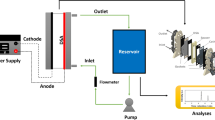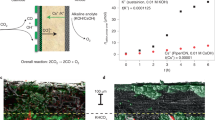Abstract
The mass transfer conditions in a hydrocyclone cell have been analysed and an approximate plug-flow model has been developed to describe metal ion depletion during batch recycle operation. The resulting concentration-time relationship and reaction rate equation has been shown to describe satisfactorily the experimental data obtained for the electrodeposition of copper and silver from dilute solutions. Moreover, these relationships have enabled the evaluation of mass transfer coefficients in the hydrocyclone cell.
Similar content being viewed by others
Abbreviations
- a 1,a 2,b :
-
numerical exponents
- C :
-
concentration (mol dm−3)
- C o :
-
initial bath concentration (mol dm−3)
- C(0):
-
cell inlet concentration (mol dm−3)
- C(L):
-
cell outlet concentration (mol dm−3)
- k :
-
rate constant (h−1)
- K :
-
mass transfer coefficient (ms−1)
- K L :
-
volumetric mass transfer coefficient = 2πRLK (m3 s−1)
- L :
-
‘active’ length of the cylindrical cathode (m)
- Q :
-
volumetric flow rate (m3 s−1)
- r :
-
inside radius of the conical part of the cell
- r A :
-
reaction rate of component A (mol dm−3 h−1)
- R :
-
inside radius of the cylindrical part of the cell (m)
- t :
-
time
- u :
-
vertical (axial) velocity in the annulus
- U :
-
cell voltage (V)
- υt :
-
horizontal (tangential) velocity in the annulus
- V B :
-
volume of the reservoir/bath
- V R :
-
volume of the cell/reactor
- τB :
-
residence of time of the reservoir
References
D. Bradley, ‘The Hydrocyclone’, Pergamon Press, Oxford (1965) pp. 9–20.
R. W. Day,Chem. Engng. Prog. 69 (1973) 67.
N. Dhamo and R. Kammel,Metall 46 (9), (1992) 912.
D. Bradley,, pp. 107–122.
R. H. Perry, D. W. Green and J.O. Maloney, ‘Perry's Chemical Engineers' Handbook’ 6th edn. McGrawHill, New York (1984) section 20 (82).
D. S. Azbel, N. P. Cheremisinoff, ‘Fluid Mechanics and Unit Operations’, Ann Arbor Science Publications (1983) pp. 608–612.
R. E. W. Jansson,Electrochim. Acta 23 (1978) 1345.
D. R. Gabe,J. Appl. Electrochem. 4 (1974) 91.
N. A. Pakryvailo, E. B. Kaberdina and M.I. Syrkin,ibid. 21 (1991) 1077.
D. R. Gabe and D. J. Robinson,Electrochim. Acta 17 (1972) 1121.
A. F. S. Afshar and D. R. Gabe,J. Appl. Electrochem. 21 (1991) 32.
L. J. J. Janssen and J. G. Wijers,ibid. 19 (1989) 823.
J. Legrand, P. Legentilhomme and H. Aouabed, Electrochim. Acta25 (1980) 669.
J. C. Cox,US Patent 4 372 829 (1983).
K. R. Houseman,US Patent 4 439 300 (1984).
S. M. Zuwala and L. D. Cass,US Patent 4 530 748 (1985).
F. C. Walsh and G. Wilson,Trans. Inst. Met. Finish. 64 (1986) 55.
R. J. Herbst and R. R. Renk,PCT Int. Appl. WO 88 09 772 (1988).
P. Legentilhomme and J. Legrand,J. Appl. Electrochem. 20 (1990) 216.
J. Legrand, P. Dumargue and F. Coeuret,J. Appl. Electrochem. 21 (1991) 1063.
D. F. Kelsall,Trans. Insm. Chem. Engrs. 30 (1952) 87.
A. T. S. Walker and A. A. Wragg, Electrochim. Acta22 (1977) 1129.
L. H. Mustoe and A. A. Wragg,J. Appl. Electrochem. 8 (1978) 467.
D. J. Pickett,Electrochim. Acta 18 (1973) 835.
O. Levenspiel, ‘Chemical Reactor Engineering’, 2nd edn John Wiley & Sons, New York (1972) p. 67.
R. E. W. Jansson and G.A. Ashworth,Electrochim. Acta 22 (1977) 1301.
T. Sasaki and T. Tshikawa, Electrochim. Acta31 (1986) 745.
V. A. Ettel, B. V. Tilak and A. S. Gendron, J Electrochem. Soc.121 (1974) 867.
S. Ehdaie, M. Fleischmann and R. E. W. Jansson, J. Appl. Electrochem.12 (1982) 59.
Author information
Authors and Affiliations
Rights and permissions
About this article
Cite this article
Dhamo, N. An electrochemical hydrocyclone cell for the treatment of dilute solutions: approximate plug-flow model for electrodeposition kinetics. J Appl Electrochem 24, 745–750 (1994). https://doi.org/10.1007/BF00578089
Received:
Revised:
Issue Date:
DOI: https://doi.org/10.1007/BF00578089




